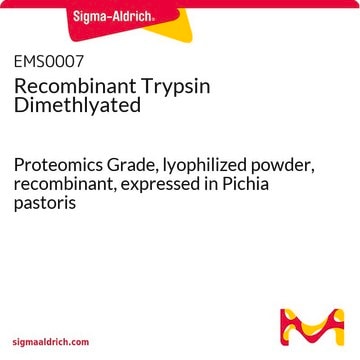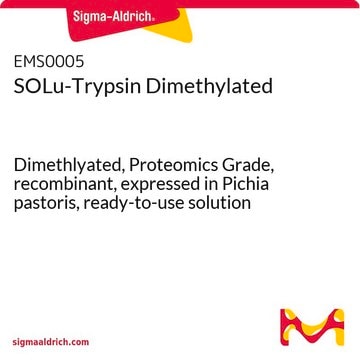TRYPSEQ-RO
Roche
Trypsin Sequencing Grade
from bovine pancreas
Synonyme(s) :
trypsin
About This Item
Produits recommandés
Source biologique
bovine pancreas
Niveau de qualité
Forme
lyophilized (salt-free)
Activité spécifique
≥80 units/mg protein
Poids mol.
Mr 23.5 kDa
Conditionnement
pkg of 4 × 100 μg (11047841001)
pkg of 4 × 25 μg (11418475001)
Fabricant/nom de marque
Roche
pH optimal
8.0
Température de stockage
2-8°C
Catégories apparentées
Description générale
Spécificité
Specificity (HPLC, with Insulin Box):
Cleavage after 1 hour: ≥90%;
Unspecific cleavage products after 18 hours: ≤10%
Application
The enzyme is used for protein-structure elucidation, tryptic mapping, fingerprinting, sequence analysis, and translocation studies. Trypsin Sequencing Grade generates glycopeptides from purified glycoproteins and is suited for the digestion of proteins in polyacrylamide gels.
Qualité
Notes préparatoires
Working concentration: 1/100 to 1/20 of the protein by weight (in solution); 1-5 μg/100 μl (for in-gel digest)
Storage conditions (working solution): A solution in 0.01% trifluoroacetic acid (TFA), (v/v) or 1 mM HCl may be used for one week at maximum, if stored at 2 to 8 °C. By incubation of proteins in solution at neutral to slightly basic pH-values partial autolysis might occur. For this application, Roche recommends Trypsin, Modified, Sequencing Grade.
Reconstitution
Autres remarques
Mention d'avertissement
Danger
Mentions de danger
Conseils de prudence
Classification des risques
Eye Irrit. 2 - Resp. Sens. 1 - Skin Irrit. 2 - STOT SE 3
Organes cibles
Respiratory system
Code de la classe de stockage
11 - Combustible Solids
Classe de danger pour l'eau (WGK)
WGK 1
Point d'éclair (°F)
does not flash
Point d'éclair (°C)
does not flash
Certificats d'analyse (COA)
Recherchez un Certificats d'analyse (COA) en saisissant le numéro de lot du produit. Les numéros de lot figurent sur l'étiquette du produit après les mots "Lot" ou "Batch".
Déjà en possession de ce produit ?
Retrouvez la documentation relative aux produits que vous avez récemment achetés dans la Bibliothèque de documents.
Les clients ont également consulté
Notre équipe de scientifiques dispose d'une expérience dans tous les secteurs de la recherche, notamment en sciences de la vie, science des matériaux, synthèse chimique, chromatographie, analyse et dans de nombreux autres domaines..
Contacter notre Service technique












